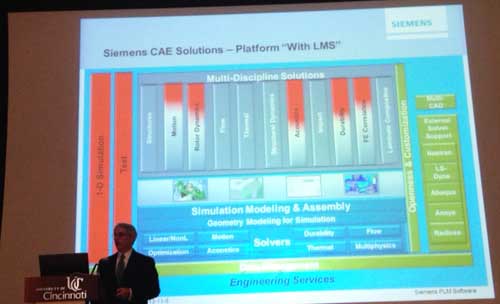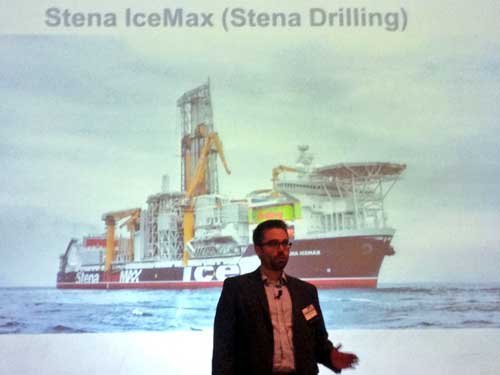Advancing Toward the Goal of Complete System Simulation

Dave Shook, senior vice president and managing director, Americas, Siemens PLM Software, explains how LMS will be integrated into NX over the next five to six years, beginning with NX10’s release next year.
Latest News
November 7, 2013
This week’s Siemens PLM Software NX CAE Symposium 2013 at the University of Cincinnati featured more than two dozen presentations, roundtables, and panel discussions, as well as two workshop tracks. Siemens PLM Software NX customers explained how they used the software to simulate everything from tiny 0.015mm cardiovascular stents to huge, ship-based cranes and heavy-lift rockets. While the simulation projects were varied, there was a common theme running throughout the symposium: the need to reduce cycle times via collaboration and system-level engineering.
“The rate of innovation and the rate of development … and bringing (products) to market is speeding along at a rate that most of the people in this room can only imagine,” said the opening presenter Dave Shook, senior vice president and managing director, Americas, for Siemens PLM Software. “You can’t take weeks or months to go do this. It needs to be done in hours, not days to bring together the mechanics and the software … It’s the whole closed-loop process.”
That vision of a closed-loop process — one platform for the entire design cycle, including testing — is what drove the $750 million acquisition of LMS by Siemens that we reported on last year.
“I spent my whole life in MCAE and this was, and still is I believe, the largest acquisition in the history of MCAE,” said industry veteran and consultant Dennis Nagy, principal of BeyondCAE, in his presentation at the symposium. (Nagy shared his initial thoughts on the acquisition via a Virtual Desktop blog post last year.) “What struck me about it was Siemens PLM’s strategic emphasis on the role and positioning of the LMS acquisition to support what a lot of us are calling the mechatronics convergence.”
Design engineers and analysts are increasingly called upon to design and test products that have integrated mechanical components, electronics and software as part of a complete system. While that convergence is already a fact of life for engineers in many different industries, software tools to support it have lagged. Siemens PLM Software’s aim is to create a platform to support that convergence.
@SiemensPLM Dave Shook: Ford has as much software in some compact cars as Boeing has in some planes. #NXCAE13 pic.twitter.com/rBkTZxSeqJ— DE Editors (@DEeditor) November 5, 2013
“The idea here is that our solutions do have to link together,” said Jim Rusk, senior vice president of Product Engineering Software for Siemens PLM Software. “They have to be able to provide collaboration capabilities across different disciplines and make that information available to the enterprise through an information backbone.
“For us, this is all about verification and verification management,” Rusk continued, addressing the LMS acquisition. “It’s an important part of the product lifecycle. Where this is heading is the linkage of that information into the information backbone of Teamcenter so it can get reused and reapplied in other important areas.”
Users Speed the Design Cycle
The user presentations, which included representatives from GM, ATK, Honeywell, ATA, Lam Research, Siemens Energy, Graham Packaging, GE Aviation and more, often illustrated the benefits of collaboration and an optimized workflow.
“Time to market has to be faster with every product we design,” said Mike Benedict of National Oilwell Varco, which designs marine cranes. He explained that he doesn’t have the luxury of multiple tests. After just one strain gauge test (which has to be passed the first time), the “first prototype is being delivered to our customers.” To do that requires several engineers of different disciplines working on the project at the same time, which requires close collaboration via tools that support that simultaneous analysis and design process.
Another presenter who only gets one chance to get it right provided the keynote address yesterday. Marc Solomon from United Launch Alliance explained how the company approaches the design of rockets, some of which took the Rover Curiosity to Mars and are scheduled to carry the Mars Atmosphere and Volatile EvolutioN (MAVEN) mission into space later this month.
Keynote speaker Marc Solomon from @LAUNCHULA (ULA): “We’re probably the most famous rocket company you’ve never heard of.” #nxcae13— DE Editors (@DEeditor) November 6, 2013
Solomon explained how the company strives to reduce human input (and therefore human error) from the design and analysis process whenever possible.
“We have many, many steps of analysis, each one providing assumptions and data to the next — filtering out and moving into multiple other disciplines and coming back with different versions,” Solomon says. “Our solution is to establish this language by trying to figure out how do we transmit the product from one analysis group to another in a language … that’s recognizable and also machine readable. So ultimately, if we manage this lexicon, we can establish mechanisms to feed these to tools without human touch.”
Solomon uses Teamcenter to manage that language and process, and help retain the knowledge needed to model the part. “These parameters are really what is the value,” he says. “In Teamcenter our use of object types and relationships let the data connect to itself.”
You can read more about ULA’s process in the December cover story of Desktop Engineering.
Like most companies, ULA and the other presenters are looking to collaboration via data management and sharing as a means to optimize their increasingly complex design processes and reduce the design cycle.
To get an idea of the range of NX projects presented at the symposium, watch the video overviews below.
The first video was taken at the symposium. It provides a brief look at the work of doctoral student Shannon Gott — with NX help from Saratech — in developing a new type of stent. It is followed by a copy of their presentation slides.
The next video, produced by Siemens PLM Software, shows how Graham Packaging uses NX to reduce cycle time by about 20%. Graham produces about 16 billion bottles per year.
Subscribe to our FREE magazine, FREE email newsletters or both!
Latest News
About the Author
Jamie Gooch is the former editorial director of Digital Engineering.
Follow DE








